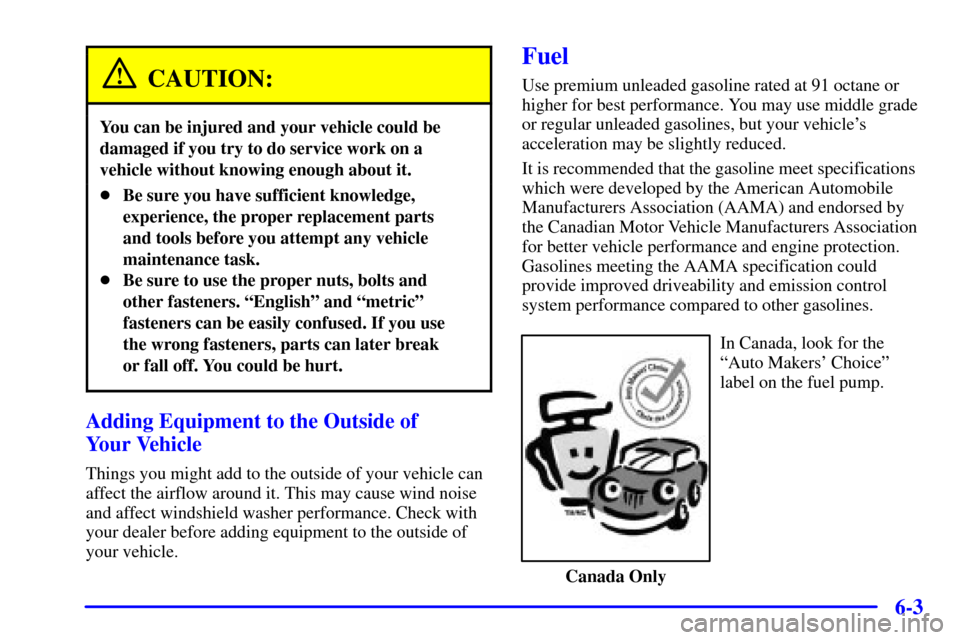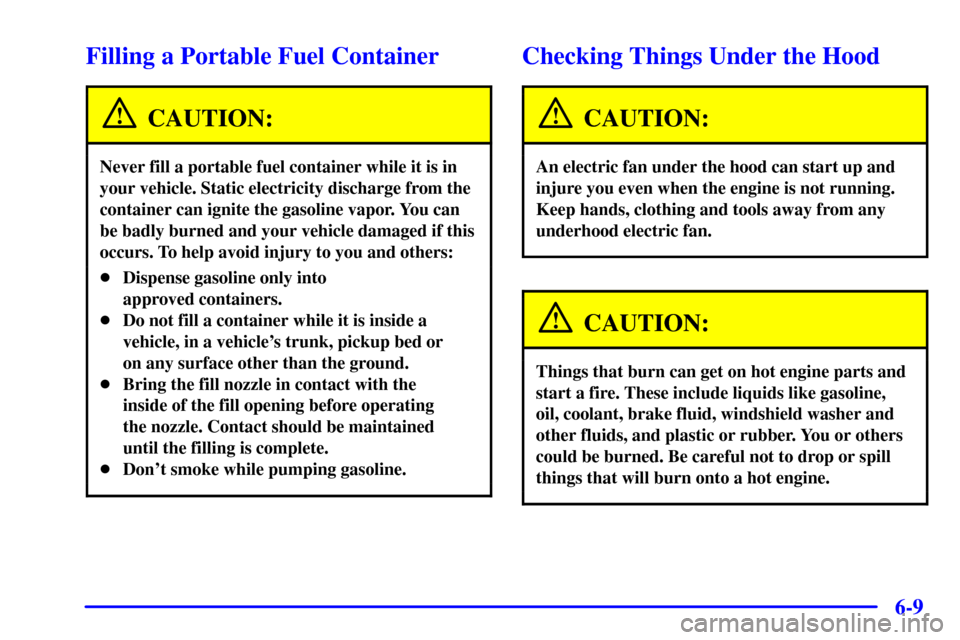Page 154 of 383

2-92
Fuel Gage
Your fuel gage tells you
about how much fuel you
have left when the ignition
is on.
When the needle approaches the red zone, RESERVE
FUEL will appear on the Driver Information Center (DIC)
display. When the needle approaches the ªE,º LOW FUEL
will appear on the display. At this time, you still have a
little fuel left, but you should get more soon.
Press RESET to acknowledge a DIC message(s). Pressing
RESET will also turn off a DIC message but the LOW
FUEL message will come on again in 10 minutes if you
have not added fuel to the vehicle.
Here are four things that some owners ask about. All
these things are normal and do not indicate that anything
is wrong with the fuel gage.�At the gas station, the gas pump shuts off before the
gage reads F (full).
�It takes more (or less) fuel to fill up than the gage
reads. For example, the gage reads half full, but it took
more (or less) than half of the tank's capacity to fit it.
�The gage pointer may move while cornering, braking
or speeding up.
�The gage may not indicate E (empty) when the
ignition is turned off.
�The gage reading may change slightly within the
first several minutes after starting the vehicle.
You can use the Driver Information Center (DIC) to
display more detailed fuel information. Each time you
press FUEL, one of the following will appear in the
Driver Information Center (DIC).
�AVERAGE: The fuel economy calculated for the
current tank of fuel, or since you last reset the display.
�INST: The fuel economy calculated for your current
driving conditions.
�RANGE: The distance you can drive before refueling.
�BLANK: The fuel gage is displayed alone.
You should reset the fuel information display every time
you refuel. To reset the display, press FUEL until
AVERAGE appears. Then, press RESET on the
Driver Information Center (DIC).
Page 272 of 383

6-3
CAUTION:
You can be injured and your vehicle could be
damaged if you try to do service work on a
vehicle without knowing enough about it.
�Be sure you have sufficient knowledge,
experience, the proper replacement parts
and tools before you attempt any vehicle
maintenance task.
�Be sure to use the proper nuts, bolts and
other fasteners. ªEnglishº and ªmetricº
fasteners can be easily confused. If you use
the wrong fasteners, parts can later break
or fall off. You could be hurt.
Adding Equipment to the Outside of
Your Vehicle
Things you might add to the outside of your vehicle can
affect the airflow around it. This may cause wind noise
and affect windshield washer performance. Check with
your dealer before adding equipment to the outside of
your vehicle.
Fuel
Use premium unleaded gasoline rated at 91 octane or
higher for best performance. You may use middle grade
or regular unleaded gasolines, but your vehicle's
acceleration may be slightly reduced.
It is recommended that the gasoline meet specifications
which were developed by the American Automobile
Manufacturers Association (AAMA) and endorsed by
the Canadian Motor Vehicle Manufacturers Association
for better vehicle performance and engine protection.
Gasolines meeting the AAMA specification could
provide improved driveability and emission control
system performance compared to other gasolines.
In Canada, look for the
ªAuto Makers' Choiceº
label on the fuel pump.
Canada Only
Page 278 of 383

6-9
Filling a Portable Fuel Container
CAUTION:
Never fill a portable fuel container while it is in
your vehicle. Static electricity discharge from the
container can ignite the gasoline vapor. You can
be badly burned and your vehicle damaged if this
occurs. To help avoid injury to you and others:
�Dispense gasoline only into
approved containers.
�Do not fill a container while it is inside a
vehicle, in a vehicle's trunk, pickup bed or
on any surface other than the ground.
�Bring the fill nozzle in contact with the
inside of the fill opening before operating
the nozzle. Contact should be maintained
until the filling is complete.
�Don't smoke while pumping gasoline.
Checking Things Under the Hood
CAUTION:
An electric fan under the hood can start up and
injure you even when the engine is not running.
Keep hands, clothing and tools away from any
underhood electric fan.
CAUTION:
Things that burn can get on hot engine parts and
start a fire. These include liquids like gasoline,
oil, coolant, brake fluid, windshield washer and
other fluids, and plastic or rubber. You or others
could be burned. Be careful not to drop or spill
things that will burn onto a hot engine.
Page 342 of 383
6-73
Minifuse Usage
6 Fog Lamp
7 Selective Real Time Damping
(SRTD) Relay
8 Headlamp Low
-Beam Right
9 Headlamp High
-Beam Right
10 Headlamp Low
-Beam Left
11 Horn
12 Headlamp High
-Beam Left
13 Fuel Pump
14 Cooling Fan
- Ignition 3
15 Oxygen Sensor
16 Powertrain Control Module
17 Throttle Control
18 Injector 2
19 Engine Ignition
20 Blank
21 Blank
22 Injector 1
23 Powertrain Control ModuleMinifuse Usage
24 Air Conditioning
25 Blank
26 Blank
27 Spare
28 Spare
29 Spare
30 Spare
31 Spare
32 Spare
Micro Relay Usage
33 Air Pump
34 Air Conditioner and Clutch
35 Fuel Pump
36 Horn
37 Rear Fog Lamp
38 Back
-Up Lamps
39 Fog Lamp
40 Blank
41 Selective Real Time
Damping (SRTD)